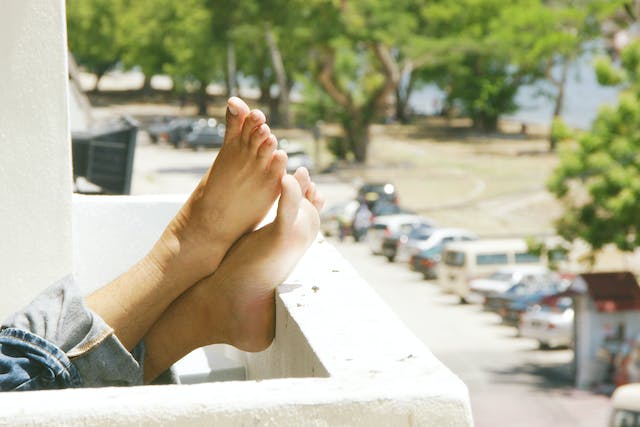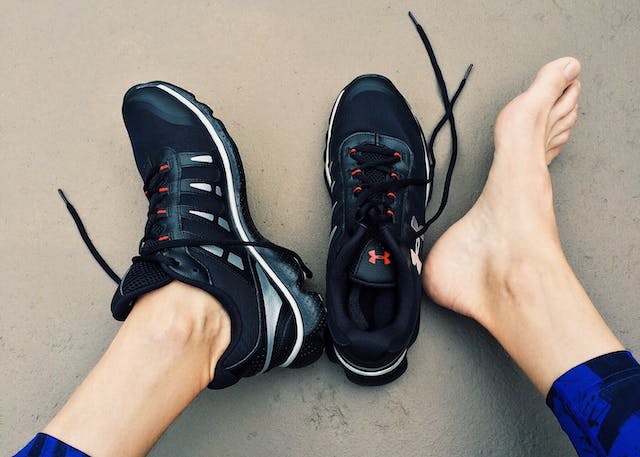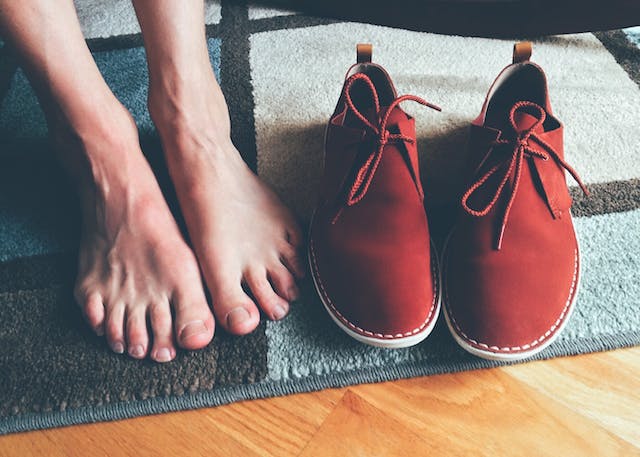Plantar fasciitis is a common condition that affects the bottom of the foot and heel. It is caused by inflammation of the plantar fascia, a thick band of tissue that connects the heel bone to the toes. Plantar fasciitis can be a painful and debilitating condition, but there are steps you can take to cure it in just one week.
Understanding Plantar Fasciitis
Plantar fasciitis is a condition that affects millions of people worldwide. It is caused by inflammation of the plantar fascia, which is a thick band of tissue that runs along the bottom of the foot. The plantar fascia is responsible for supporting the arch of the foot and absorbing shock when you walk or run. When the plantar fascia is inflamed, it can cause pain and discomfort in the heel and bottom of the foot.
Treatment Plan
While plantar fasciitis can be a painful and debilitating condition, there are steps you can take to cure it in just one week. A treatment plan for plantar fasciitis typically includes exercises and stretches, supportive footwear and orthotics, and lifestyle changes. By following a comprehensive treatment plan, you can alleviate pain and inflammation, and get back to your regular activities in no time.
Key Takeaways
- Plantar fasciitis is caused by inflammation of the plantar fascia, which is a thick band of tissue that runs along the bottom of the foot.
- A treatment plan for plantar fasciitis typically includes exercises and stretches, supportive footwear and orthotics, and lifestyle changes.
- By following a comprehensive treatment plan, you can cure plantar fasciitis in just one week.
Understanding Plantar Fasciitis
Plantar Fasciitis is a common foot condition that causes chronic pain in the heel and bottom of the foot. The plantar fascia ligament is a thick band of tissue that runs from the heel bone to the toes, and it is responsible for supporting the arch of the foot. When this ligament becomes inflamed, it can cause pain and discomfort.
Plantar Fasciitis is most commonly caused by repetitive strain on the plantar fascia ligament. This can occur from activities such as running, jumping, or standing for long periods of time. It can also be caused by wearing shoes that do not provide proper support or cushioning for the feet.
Symptoms of Plantar Fasciitis include pain in the heel or bottom of the foot, especially in the morning or after periods of rest. The pain may also worsen after physical activity or prolonged standing. In some cases, the pain may be accompanied by swelling or redness in the affected area.
Treatment for Plantar Fasciitis typically involves rest, ice, and stretching exercises to help alleviate pain and reduce inflammation. In more severe cases, a doctor may recommend physical therapy, orthotic inserts, or even surgery to correct the condition.
It is important to seek medical attention if you are experiencing chronic pain in the heel or bottom of your foot, as untreated Plantar Fasciitis can lead to long-term damage and disability. With proper treatment and care, however, most cases of Plantar Fasciitis can be successfully cured within a week.
Causes and Risk Factors
Plantar fasciitis occurs when the plantar fascia, a thick band of tissue that runs across the bottom of the foot, becomes inflamed. There are several factors that can contribute to the development of plantar fasciitis, including age, weight, and overuse.
Age can be a contributing factor, as the plantar fascia loses elasticity over time and becomes less capable of absorbing shock. Weight can also play a role, as excess weight places additional stress on the plantar fascia. This is especially true for individuals who are overweight or obese.
Runners and other athletes who engage in high-impact activities are also at risk for developing plantar fasciitis. This is because the repetitive stress of running or jumping can cause small tears in the plantar fascia, leading to inflammation and pain.
Improper footwear, such as high heels or shoes with inadequate arch support, can also contribute to the development of plantar fasciitis. Flat feet or high arches can also increase the risk of developing plantar fasciitis.
Overuse is another common cause of plantar fasciitis. Individuals who engage in activities that involve prolonged standing or walking may be at risk for developing plantar fasciitis, especially if they do not take adequate breaks or wear appropriate footwear.
Overall, plantar fasciitis is a condition that can develop due to a combination of factors. By addressing these risk factors and taking steps to prevent further damage, individuals can reduce their risk of developing plantar fasciitis and promote faster healing.
Recognizing the Symptoms
Plantar fasciitis is a common foot condition that affects millions of people worldwide. It is caused by the inflammation of the plantar fascia, a thick band of tissue that runs along the bottom of the foot. The condition is characterized by pain and tenderness in the heel or arch of the foot, especially after prolonged periods of standing or walking.
The most common symptom of plantar fasciitis is heel pain. This pain is usually felt in the morning, after getting out of bed, and can be described as a sharp, stabbing pain. The pain may also be felt after sitting for a long period of time, or after standing for a long period of time. In some cases, the pain may be felt in the arch of the foot.
Another symptom of plantar fasciitis is stiffness in the foot. This stiffness may be felt in the morning, or after prolonged periods of sitting or standing. The stiffness may also be accompanied by swelling in the foot.
In addition to pain and stiffness, plantar fasciitis may also cause tenderness in the foot. This tenderness may be felt in the heel or arch of the foot, and may be accompanied by a feeling of pressure.
If you are experiencing any of these symptoms, it is important to seek medical attention. Your doctor can diagnose plantar fasciitis and recommend a treatment plan that is right for you.
Professional Diagnosis
If you suspect you have plantar fasciitis, it is important to get a professional diagnosis. A doctor or podiatrist can examine your foot and determine if you have plantar fasciitis or another condition that mimics its symptoms.
During the examination, the doctor or podiatrist will ask you about your symptoms and medical history. They will also perform a physical examination of your foot, looking for signs of inflammation or tenderness in the heel and arch. In some cases, they may order imaging tests such as an X-ray or MRI to rule out other conditions.
Once a diagnosis of plantar fasciitis is confirmed, the doctor or podiatrist can recommend a treatment plan based on the severity of your symptoms. This may include rest, ice, stretching exercises, physical therapy, or the use of orthotics or other devices to support the foot.
It is important to follow the treatment plan recommended by your doctor or podiatrist, as failure to do so can lead to chronic pain and disability. In some cases, surgery may be necessary to correct the problem, but this is usually a last resort and is only recommended in severe cases that do not respond to other treatments.
Overall, getting a professional diagnosis is the first step in treating plantar fasciitis. By working with a doctor or podiatrist, you can develop a treatment plan that is tailored to your specific needs and get back on your feet in no time.
Treatment Plan
The treatment plan for plantar fasciitis typically involves a combination of physical therapy, medication, and the use of splints or night splints. In most cases, patients can expect to see significant improvement within one week of starting treatment.
Physical therapy is a key component of any treatment plan for plantar fasciitis. This may include manual therapy, dry needling, ultrasound, or electrical stimulation. These techniques can help to reduce pain and inflammation, and improve mobility in the affected foot.
Medication can also be effective in treating plantar fasciitis. Over-the-counter medications such as nonsteroidal anti-inflammatory drugs (NSAIDs) like ibuprofen can help to reduce pain and inflammation. In some cases, steroids may be prescribed to reduce inflammation and pain.
The use of a splint or night splint can also be helpful in treating plantar fasciitis. These devices help to stretch the plantar fascia while you sleep, which can reduce pain and inflammation in the morning.
Injections may also be used in severe cases of plantar fasciitis. These injections may include corticosteroids or platelet-rich plasma (PRP) to reduce inflammation and promote healing.
Overall, a combination of physical therapy, medication, and the use of splints or night splints can be an effective treatment plan for plantar fasciitis. In some cases, surgery may be necessary to correct the underlying problem. However, with proper treatment, most patients can expect to see significant improvement within one week.
Exercises and Stretches
Plantar fasciitis can be cured in one week with proper exercises and stretches. Here are some exercises and stretches that can help alleviate the pain and inflammation:
Stretching Exercises
Stretching exercises are essential in relieving plantar fasciitis pain. The following stretches can be done at home:
- Calf Stretch: Stand facing a wall and place your hands on the wall. Step one foot back while keeping the other foot forward. Keep your back leg straight and your heel on the ground. Hold the stretch for 30 seconds and repeat on the other leg.
- Toe Stretch: Sit on a chair and place a towel under your toes. Pull the towel towards you, keeping your heel on the ground. Hold the stretch for 30 seconds and repeat on the other foot.
Strengthening Exercises
Strengthening exercises can help prevent plantar fasciitis from recurring. The following exercises can be done at home:
- Heel Raises: Stand with your feet shoulder-width apart and raise your heels off the ground. Hold for 3 seconds and lower your heels back down. Repeat 10 times.
- Walking on Toes: Walk on your toes for 30 seconds and then walk on your heels for 30 seconds. Repeat 5 times.
Self-Massage
Self-massage can help reduce pain and inflammation caused by plantar fasciitis. Use a tennis ball or a frozen water bottle to massage the bottom of your foot. Roll the ball or bottle under your foot for 5 minutes.
By incorporating these exercises and stretches into your daily routine, you can cure plantar fasciitis in one week. However, it is important to consult with a healthcare professional before starting any new exercise regimen.
Supportive Footwear and Orthotics
Wearing supportive footwear and orthotics can help alleviate the pain associated with plantar fasciitis. Shoes with good arch support and cushioning can help distribute pressure evenly across the foot and reduce stress on the plantar fascia.
Orthotics, which are custom-made shoe inserts, can also provide additional support and cushioning. They are designed to fit the shape of the foot and can help correct any biomechanical imbalances that may be contributing to the condition.
When selecting supportive footwear, it is important to choose shoes that fit well and provide adequate support. Avoid wearing shoes with worn-out soles or those that are too tight or too loose. Flip-flops and slippers should also be avoided, as they do not provide enough support for the foot.
In addition to wearing supportive footwear and orthotics, stretching exercises can also help alleviate the pain associated with plantar fasciitis. Stretching the calf muscles and the plantar fascia itself can help improve flexibility and reduce tension in the foot.
Overall, wearing supportive footwear and orthotics, combined with stretching exercises, can help alleviate the pain associated with plantar fasciitis and promote healing.
Lifestyle Changes
Making certain lifestyle changes can help alleviate the symptoms of plantar fasciitis and promote healing. Here are some tips:
- Rest: It is important to give the affected foot adequate rest. This means avoiding activities that aggravate the condition, such as running or jumping. Instead, opt for low-impact exercises like swimming or cycling.
- Ice: Applying an ice pack to the affected area can help reduce inflammation and pain. Wrap a cold pack or bag of ice in a towel and apply it to the heel for 15-20 minutes several times a day.
- Calf stretches: Tight calves can contribute to plantar fasciitis, so stretching them regularly can help alleviate symptoms. Stand facing a wall with your hands on the wall and one foot behind the other. Keep your back leg straight and your front leg bent, and lean forward until you feel a stretch in your calf. Hold for 30 seconds and repeat several times a day.
- Avoid hard surfaces: Walking or standing on hard surfaces can exacerbate plantar fasciitis. Try to walk on softer surfaces like grass or sand, or use cushioned shoes or inserts.
- Medications: Over-the-counter pain relievers like ibuprofen or acetaminophen can help alleviate pain and inflammation. However, it is important to follow the recommended dosage and not rely on medication as a long-term solution.
By incorporating these lifestyle changes into their routine, individuals with plantar fasciitis can promote healing and alleviate symptoms in a week’s time.
Prevention and Maintenance
Prevention is key when it comes to plantar fasciitis. Here are some measures that can help reduce the risk of developing this condition:
- Maintaining a healthy weight: Being overweight puts extra pressure on the feet, which can lead to plantar fasciitis.
- Wearing supportive shoes: Shoes with good arch support and cushioning can help distribute weight evenly and reduce stress on the feet.
- Gradually increasing activity: High-impact activities like running can increase the risk of plantar fasciitis, especially if the intensity or duration of the activity is increased too quickly. Gradually increasing activity can help prevent injury.
- Stretching regularly: Stretching the lower leg muscles, including the calf muscles, can help improve flexibility and reduce the risk of injury.
- Strengthening exercises: Strengthening exercises can help improve stability and reduce the risk of injury.
- Avoiding barefoot walking: Walking barefoot can increase stress on the feet and lead to plantar fasciitis.
If you have already developed plantar fasciitis, maintenance is key to preventing it from getting worse. Here are some measures that can help with pain relief and healing:
- Rest: Resting the affected foot can help reduce pain and inflammation.
- Ice: Applying ice to the affected area can help reduce pain and inflammation.
- Home remedies: Home remedies like massage, using a tennis ball or foam roller to stretch the foot, or using a night splint can help relieve pain and improve healing.
- Fact-check: Be careful when using home remedies and make sure to fact-check their effectiveness before trying them.
- Trigger points: Trigger points in the foot and calf muscles can contribute to plantar fasciitis. Massaging these trigger points can help relieve pain and improve healing.
- Tendons and arthritis: In some cases, plantar fasciitis can be caused by tendons or arthritis. If you suspect this is the case, it is important to seek medical attention.
Frequently Asked Questions
How can I alleviate plantar fasciitis pain quickly?
There are several ways to alleviate plantar fasciitis pain quickly. One of the most effective ways is to apply ice to the affected area for 15-20 minutes at a time, several times a day. Another way is to take over-the-counter pain relievers such as ibuprofen or acetaminophen. Additionally, wearing shoes with good arch support and cushioning can help alleviate pain.
What are the best stretches for plantar fasciitis?
Some of the best stretches for plantar fasciitis include calf stretches, toe stretches, and plantar fascia stretches. To perform a calf stretch, stand facing a wall with your hands on the wall at shoulder height. Step back with one foot and keep your heel on the ground. Lean forward until you feel a stretch in your calf. To perform a toe stretch, sit with one leg crossed over the other and pull your toes back toward your shin. To perform a plantar fascia stretch, sit with one leg crossed over the other and pull your toes back toward your shin while also pulling your foot back toward your shin.
Which exercises can help with plantar fasciitis?
Exercises that can help with plantar fasciitis include calf raises, toe curls, and foot flexes. To perform a calf raise, stand with your feet hip-width apart and slowly raise up onto your toes. Hold for a few seconds and then lower back down. To perform a toe curl, place a towel on the floor and use your toes to scrunch it up toward you. To perform a foot flex, sit with your legs straight out in front of you and flex your feet back toward your shins.
What are some effective treatments for plantar fasciitis?
Some effective treatments for plantar fasciitis include physical therapy, corticosteroid injections, and night splints. Physical therapy can help strengthen the muscles in your feet and legs, which can help alleviate pain. Corticosteroid injections can help reduce inflammation and pain in the affected area. Night splints can help stretch the plantar fascia while you sleep, which can help alleviate pain in the morning.
Are there any home remedies for plantar fasciitis?
Yes, there are several home remedies for plantar fasciitis. Some of these include stretching, icing, and wearing shoes with good arch support and cushioning. Additionally, taking over-the-counter pain relievers such as ibuprofen or acetaminophen can help alleviate pain.
Can walking make plantar fasciitis worse?
Yes, walking can make plantar fasciitis worse if you do not wear proper shoes or if you overdo it. It is important to wear shoes with good arch support and cushioning and to gradually increase the amount of time you spend walking. If you experience pain while walking, it is important to rest and apply ice to the affected area.














Comments are closed.